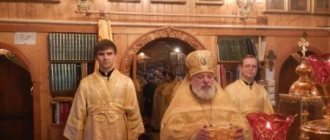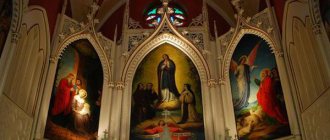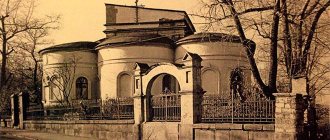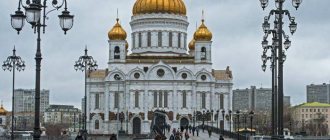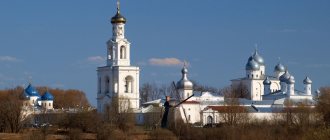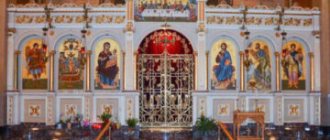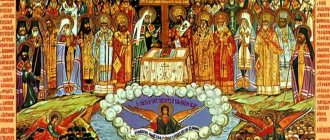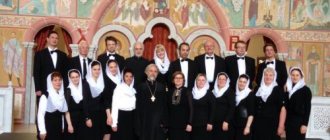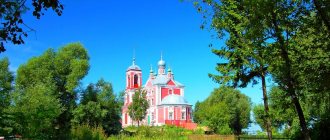Recognizing state and linguistic boundaries, from the beginning of the 12th century the church began to wield immeasurable power and achieved great power. Not a single event, be it a wedding, the sacrament of birth or death, was complete without the church. The Europeans of that time could not even imagine that things could be different. All everyday affairs, actions, even thoughts were inspired by church dogmas and were part of the order established by the church. The Catholic and Christian world was inextricably linked with religion.
Why did heretics appear?
In the Middle Ages there was not a person who did not believe in God. ... People who doubted his correctness appeared in the first centuries of Christianity. They denied the correctness of the Creed recognized by the church and preached their own doctrine. These dissenters were called heretics (Greek for “apostates”), and their teachings were called heresies.
Interesting materials:
When is the day of Daniil of Moscow? When does the day end? When is Yuri Day in Ukraine? When is Christina's day 2022? When is Jesus Christ's birthday? When is Mabee Baby's birthday? When is Urgant's birthday? When is Vlad Chizhov's birthday? When is Teacher and Educator Day 2022? When is Teacher's Day Ukraine 2020?
The Gospel as the only source of faith
What did the heretics preach and what did they achieve? People who did not recognize the dogmas of the church believed that the Gospel could be considered the only source of true faith. After all, it is there that it is written that people should be united, should help their neighbors who are worse off than themselves. The heretics called on the church to distribute its wealth and lands to the poor in order to make people equal.
Understanding what the heretics preached, it will not be surprising to learn that they themselves often gave away their wealth, gave the last to their neighbors, and themselves ate what good people gave. Heretics believed that eating alms was not a sin, but, on the contrary, a great power, “the reign of justice and equality.”
Inquisition and public burnings
The death penalty was carried out by public burning. The burning of people suspected of heresy was widespread. And if at the initial stage the victims of the Holy Inquisition were people who did not agree with the classical teachings of the church, then over time the categories of apostates increased exponentially. Attractive girls and women were accused of witchcraft and vicious relationships with the devil. Babies born with physical disabilities were considered children of Satan. Both of them faced an inevitable death fate. The families of heretics were ruined, their property was divided in half between the state treasury and the clergy.
Scientific figures, the first astronomers, chemists, and physicists, whose views radically diverged from the teachings of the church, also became victims of the Inquisition processes. Thus, the famous astronomer Galileo Galilei was able to avoid death at the stake only after he publicly renounced the teachings of Copernicus.
It is estimated that the fire of the Holy Inquisition claimed the lives of more than 12 million Europeans, 98% of whom were innocent.
Decadence
The medieval structure of society and the role of religion in it. What was the papal power and who were the heretics.- What ideas about the structure of society, about exemplary behavior, about poverty and wealth did the church affirm? Did the church itself follow these statements?
Church thinkers identified three classes of which society should consist:
- Clergy - monks and priests, whose duty was to intercede for people before God with prayers.
- Warriors are mainly feudal lords who carry out military service and protect the Christian population from enemies.
- Peasants and townspeople - this class included everyone who was not included in the first two. They provided the rest of the classes with everything they needed.
The clergy was considered the main class, since it was a mediator between God and people, and was also the custodian of the teaching on how a person can go to heaven after death.
The main rule in Christian morality was to treat others the way you would like to be treated.
The Church taught that earthly goods and wealth are harmful and lead to conflicts and enmity. However, despite such views, the representatives of the clergy themselves often had huge fortunes, as well as fertile lands and dependent peasants.
- What was the main reason for the division of churches?
In the Middle Ages, followers of the Christian faith developed certain rules and immutable truths, for example, the statement about the Holy Trinity - the unity of God in three persons: God the father, God the son and God the holy spirit.
All dogmas and rules were observed among all Christians, regardless of their location. However, in the middle of the 11th century, a conflict arose between the two heads of the Christian world - the Pope and the Byzantine Patriarch. The conflict arose due to the division of spheres of influence in different European countries.
The result of this conflict was the division of the church into the Catholic, which means “worldwide,” and the Orthodox, which translates as “correctly glorifying God.” The difference between the new churches was not only in the name - they interpreted the Holy Scriptures differently, conducted rituals differently, and in general became completely independent and isolated from each other.
- Give facts that indicate that under Innocent III the power of the pope reached its greatest power.
Pope Innocent III was the head of the Catholic Church in the early 13th century. He was remembered by his descendants for his flexible mind, strong will and great abilities. Innocent III significantly expanded the boundaries of the papal region, and also greatly increased his influence over European monarchs. His influence was so great that the kings of England, Poland and several other states recognized themselves as vassals of Innocent III.
- What did the heretics preach?
The term heretic means a person who is an opponent of the prevailing doctrine of the church. Moreover, in religious terms, all medieval heretics followed the spiritual traditions of the Gospel. The heretics' disagreement with the church consisted of censure of the greed of the clergy, the pomp of rituals, the amount of tithes that peasants were obliged to regularly pay to the church, as well as the abuse of power.
- How did the Catholic Church fight heretics?
Those people whom the Catholic Church suspected of heresy or insubordination could face severe punishment. In addition to the death penalty and persecution, the church could excommunicate a heretic from the church. This was a terrible punishment for a believer, as he was deprived of access to sacred rites:
- baptism;
- funeral services after death;
- confession, etc.
Consequently, after death his soul was doomed to hellish torment. In addition, people faithful to the church were forbidden to provide help and support to the excommunicated person.
- What are mendicant orders?
The so-called mendicant orders were monastic orders that were founded under the patronage of the Pope. The head of the Catholic Church at the beginning of the 13th century saw how the people revered those who voluntarily abandoned earthly goods and lived in poverty. The Pope supported people such as Francis of Assisi, Dominic Guzman, Berthold of Calabria, and others.
Francis of Assisi was from a wealthy family, but became a monk, refusing benefits. He preached goodness and love, traveled around Italy, calling on people to repent and live off alms. Thanks to the patronage of Pope Innocent III, Francis of Assisi founded the Franciscan Order, which promoted asceticism and love of neighbor.
All monastic mendicant orders existed on voluntary donations, had neither private nor public property, and all their members took a vow of poverty.
- Which monastic order especially helped the pope in the fight against heresies? What did this mean?
At the beginning of the 13th century, the Dominican mendicant order was founded by monk Dominic Guzman. The order's main task was to fight heretics and protect the foundations of orthodoxy.
At its peak, the order had more than 150,000 members. In 1232, the Pope transferred the Inquisition to the order. Most of the judges and ministers of the Inquisition were Dominican monks. The Dominican coat of arms depicted a dog holding a burning torch in its mouth. This image had a double meaning - the torch signified the order’s intention to bring the word of the Lord to people, and also to protect the Catholic faith from heresy.
- Draw a diagram of “The Sources of the Church’s Wealth.”
The main source of wealth for the medieval church was a special type of tax called tithe. All residents of Western Europe had to pay it, and usually this tax amounted to a tenth of a person’s income, be it an ordinary peasant or a nobleman. Also, sources of wealth for the clergy include paid services provided by the church, such as baptism, weddings, funeral services for the dead, and so on.
Often people voluntarily donated their money and property to the church, and the clergy in every possible way encouraged such generosity, recognizing it as one of the main virtues.
- Under Gregory VI, Catholic clergy were prohibited from marrying. Guess why celibacy of the clergy was introduced. Find out whether this custom has survived to this day.
Pope Gregory VI carried out many church reforms, and one of the most famous was the famous celibacy, which translated from Latin means a vow of celibacy, which became mandatory for all clergy.
Gregory VI was convinced that family ties and the everyday problems that accompany them only distract the clergy from their sacred duty - serving the Lord. In addition to this reason, there was another one - to reduce the abuse by clergy of their powers, which manifested themselves in granting privileges to their relatives, for example, such as the distribution of church lands or positions.
An interesting fact is that initially celibacy was introduced only for the highest clergy, but those who were in a minor church rank, such as deacons, very rarely married, since any such minor rank was always only a step on the career ladder.
In our days, celibacy of the clergy has been preserved. It is observed especially strictly by Catholics, for whom no church rank has the right to marry. This is currently the subject of heated debate, with many considering such a vow to be unjustifiably harsh. In Orthodoxy this custom is also preserved, but it applies only to monasticism.
Explain the statement of the church writer: “The rich were created to save the poor, and the poor were created to save the rich.”
In the society of medieval Catholic Europe, according to the principles of church morality, the attitude towards material wealth was negative - it was believed that wealth distracts from concerns about saving the soul and leads to hatred and enmity.
According to church canons, according to which asceticism was considered the main virtue, it was very difficult for a rich person to get to heaven after death. The only way for a medieval rich man to save his soul was to voluntarily donate his wealth to the poor. Thus, it turned out that a rich man saved the lives of the poor with his charity, and poor people, accepting support, saved the souls of rich people.
3. Why did the trade in indulgences cause outrage among true believers?
The Catholic Church in the Middle Ages had the right of indulgence. Indulgence means “mercy” translated from Latin, that is, forgiveness of sins. Typically, an indulgence was used by a priest after confession and repentance of a believer, for the remission of his sins.
To increase income, church leadership introduced indulgences in the form of charters that could be purchased with money. Having acquired such a certificate, one could “write off” an unlimited number of sins. This service was very popular and also brought huge income to the church budget. This cynical type of service caused indignation among true Christian believers, since it clearly violated the very meaning of the sacrament of repentance and repentance, which are necessary for the forgiveness of sin.
4. According to legend, Innocent III founded the Franciscan Order when he saw in a dream that Francis was supporting the shaky main cathedral of Rome with his shoulder. Explain how the Pope understood the meaning of his dream.
Despite the respectful attitude of religious people in medieval Catholic Europe towards asceticism and poverty, in most cases the poor were not favored on the streets of Europe. And even more so, they were superfluous in the monastery of the Pope.
Therefore, when Francis appeared to Innocent III for the first time, the Pope, in response to requests to create a monastic order, showed Francis the door.
According to legend, shortly after Francis left with nothing, the Pope had a dream in which he saw the Laterian Basilica leaning over and about to fall, and below stood a man in torn clothes, and did not allow the basilica to fall, propping it up with his shoulder . Innocent III interpreted his dream as a message from the Lord that Francis should become a support and support in the affairs of the Catholic Church. He ordered that Francis be found, and soon after that he established the Franciscan Order.
5. Why did the Catholic Church sometimes persecute heretics who believed in Christ and revered the Gospel with greater cruelty and intransigence than pagans, Muslims and Jews?
In the Middle Ages, during the time of the total dictatorship of the Pope and the Catholic Church, there were always people who openly criticized the church. They usually adhered to true Christian teachings and considered modesty and poverty to be one of the main virtues. Heretics openly condemned the greed of the clergy, the pomp and richness of church rituals, and the clergy’s desire for power.
The dominant clergy did not intend to tolerate such revelations, which threatened their positions and reputation among the population, especially from their brothers in faith. In this regard, a real hunt was announced for heretics. A special body was created to combat heresy - the Inquisition.
The Inquisition diligently persecuted opponents of the Catholic Church throughout Europe, and subjected them to terrible punishments, including the death penalty.
Source: The Power of Papal Power. Questions and answers on the history textbook of Agibalov and Donskoy. Catholic Church and heretics
What is heresy in Christianity
“Heresy” is translated from Greek as “direction,” “school,” or “choice.” This is the name of a statement or teaching that contradicts Christian dogmas (revealed truths). This is a deliberate distortion of the true doctrine and deviation from the Truth. A heretic is a conscious supporter of heretical ideology.
Orthodox church
According to Saint Ignatius Brianchaninov, when people began to accept Christianity en masse, the devil realized that attempts to return them to idolatry were futile. Therefore, he contributed to the emergence of false Christian teachings:
“Through heresy, preserving for those who adhere to it the name and some appearance of Christians, the devil not only took Christianity away from them, but also replaced it with blasphemy” (“On Heresy and Schism”).
Heresy should not be confused with apostasy from the faith, that is, a complete rejection of it. Heresy is not a renunciation of Christianity, but its distortion. It is also necessary to distinguish heresy from schism. Being a violation of church unity, schism, as a rule, does not affect issues of dogma. It is a consequence of ritual, canonical and disciplinary contradictions within the Church.
